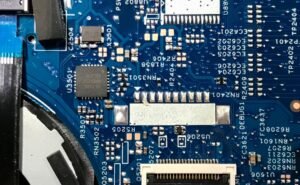No Code for Good
We live in a digital age where technology has the power to transform the world, making it crucial for organizations to adapt and leverage these capabilities. The concept of “No Code” has gained traction in recent years, enabling individuals without coding experience to build applications and solve complex problems. In this article, we will explore the concept of No Code for good and its potential to drive positive change in various sectors.
Key Takeaways
- No Code empowers individuals without coding experience to create applications and address challenges.
- No Code platforms offer user-friendly interfaces and pre-built templates to facilitate rapid development.
- No Code for good can be harnessed across sectors such as healthcare, education, and non-profit organizations.
- Embracing No Code can lead to cost and time savings while fostering innovation and inclusion.
The Power of No Code
The rise of No Code platforms, often referred to as visual development tools, has opened up new possibilities for problem-solving and innovation. These platforms allow individuals to build applications using intuitive drag-and-drop interfaces, eliminating the need for traditional programming knowledge. *No Code democratizes digital development*, enabling a larger pool of people to participate and create impactful solutions.
No Code in Healthcare
The healthcare industry can greatly benefit from No Code solutions. With the growing need for digital healthcare services, building user-friendly applications becomes essential. *No Code allows healthcare providers to develop custom solutions without relying on specialized software developers*, thereby speeding up the delivery of crucial services, such as telemedicine, patient management, and health data analysis.
| Application | Purpose |
|---|---|
| Appointment Scheduling System | Streamlines patient appointment bookings and reduces administrative efforts. |
| Medical Data Visualization Dashboard | Provides easy-to-understand visual representations of healthcare data for informed decision-making. |
No Code in Education
Education is another sector that stands to benefit from No Code solutions. *No Code empowers educators to create interactive learning platforms and tailor educational content to specific needs and learning styles*. It enables the development of e-learning applications, student progress tracking systems, and even virtual classroom environments, making education more accessible to learners worldwide.
No Code in Non-Profit Organizations
Non-profit organizations often face limited resources while striving to make a positive impact on society. No Code platforms offer an opportunity to overcome these challenges. *No Code allows non-profit organizations to build websites, donor management systems, and fundraising platforms without extensive programming knowledge*. This fosters efficiency, transparency, and scalability, enabling non-profits to reach their goals effectively and maximize social impact.
| Application | Purpose |
|---|---|
| Volunteer Management System | Facilitates volunteer registration, scheduling, and communication. |
| Donation Tracking System | Efficiently manages donor information, contributions, and acknowledgments. |
The Benefits of Embracing No Code
When organizations embrace No Code solutions, they unlock several benefits. Firstly, *No Code platforms can accelerate the application development process* by providing templates and pre-built components. This saves time, reduces costs, and allows for rapid prototyping. Additionally, No Code solutions foster innovation by enabling individuals from diverse backgrounds to participate in problem-solving, helping to generate novel ideas and solutions.
- No Code empowers individuals without coding knowledge, fostering inclusivity and collaboration.
- No Code platforms streamline development processes, reducing time and cost constraints.
- No Code solutions can drive innovation by enabling a wider pool of problem solvers.
Conclusion
No Code has emerged as a powerful tool for driving positive change across sectors. Its user-friendly interfaces, pre-built templates, and versatility make it accessible to individuals without coding experience. By embracing No Code solutions, organizations in healthcare, education, and non-profit sectors can scale their impact, foster innovation, and address societal challenges more efficiently. No Code is revolutionizing the way we build digital solutions and empowering a broader community to create technologies for good.

Common Misconceptions
Misconception 1: No coding skills means no impact
One common misconception among people is that if they do not possess coding skills, they cannot make a positive impact in the No Code for Good movement. However, this is far from the truth. There are numerous ways individuals can contribute and create change without writing code.
- Volunteering for organizations that promote No Code for Good initiatives
- Providing support and guidance to individuals who are using No Code tools
- Advocating for the recognition and adoption of No Code practices in various industries
Misconception 2: No Code tools are limited in functionality
Another misconception is that No Code tools are limited in their functionality compared to traditional coding. While it is true that No Code tools may have some limitations, they have come a long way in terms of capability and flexibility. Many No Code platforms provide a wide range of features that allow users to build complex and powerful applications.
- Building interactive websites and web applications
- Automating business processes and workflows
- Creating mobile applications without writing code
Misconception 3: No Code is only for beginners
Some people believe that No Code is only suitable for beginners or individuals with limited technical knowledge. However, No Code tools are utilized by professionals of all skill levels. Experienced developers can utilize No Code tools to rapidly prototype, test ideas, and create solutions more efficiently.
- Rapidly prototyping and iterating on ideas
- Creating proof of concepts without spending extensive time on development
- Collaborating with non-technical stakeholders during the design and development process
Misconception 4: No Code is a threat to professional developers
There is a misconception that No Code tools pose a threat to professional developers by replacing their skills and job opportunities. However, No Code tools should be seen as a complement to traditional coding practices rather than a replacement. No Code allows developers to focus on more complex tasks while delegating repetitive or low-level tasks to No Code tools.
- Working on more challenging and innovative projects
- Collaborating with No Code users to deliver efficient and effective solutions
- Learning new skills and expanding professional growth in the No Code space
Misconception 5: No Code is a passing trend
Some people perceive the No Code movement as a passing trend that will lose momentum over time. However, the increasing demand for efficient and rapid development approaches indicates that No Code is here to stay. As technology continues to evolve, No Code solutions are likely to become more powerful and widespread.
- Continuous improvement and innovation in No Code platforms
- Integration of No Code practices in educational institutes and corporate training programs
- Growing community engagement and support for No Code initiatives

No Code for Good: Unlocking the Potential of Technology for Social Impact
The power of technology to drive positive change is evident in various fields, from healthcare advancements to environmental sustainability efforts. This article explores the growing movement of “no code” solutions that democratize the creation of software, enabling individuals with little to no coding experience to build impactful applications. The following tables provide eye-opening data and insights that showcase the potential of no code for social good.
Equipping Nonprofits with DIY Tools
Nonprofits play a vital role in addressing social issues. However, limited resources can hinder their ability to develop customized software solutions. No code platforms offer a DIY approach, empowering nonprofits to create tailored tools without coding expertise.
Revolutionizing Volunteer Management
Volunteer management is essential for efficient operation of nonprofit organizations. By leveraging no code platforms, nonprofits can streamline volunteer recruitment, scheduling, and communication, enabling them to make a greater impact.
Accelerating Disaster Relief Efforts
During times of crisis, rapid response is crucial. No code solutions enable the creation of emergency assistance applications, facilitating real-time coordination among first responders, volunteers, and those affected by the disaster.
Amplifying Social Advocacy
No code platforms empower activists and advocates to effortlessly create powerful websites and advocacy tools. This ensures easy access to information, amplifying the impact of social justice movements.
Transforming Education Accessibility
Access to quality education is a global challenge. No code tools allow educators to develop interactive learning applications, fostering inclusive education environments and promoting skill development.
Enhancing Healthcare Delivery
No code solutions have the potential to improve healthcare delivery, enabling the creation of patient engagement platforms, appointment management systems, and other innovative healthcare applications.
Driving Sustainable Development
No code platforms empower individuals and organizations to develop applications that foster sustainable practices and address environmental challenges. This table presents impactful examples of such solutions.
Bridging the Tech Skills Gap
The tech industry faces a skills shortage, hindering progress. No code solutions provide an accessible entry point, allowing individuals to acquire relevant experience and enhance their employability.
Fostering Entrepreneurship
No code platforms democratize entrepreneurship, minimizing the barriers to entry for startups. Aspiring entrepreneurs can bring their ideas to life without the need for extensive coding knowledge, equipping them to drive innovation.
Innovation for All
No code solutions democratize the innovation landscape, enabling individuals from various backgrounds to contribute to technological advancements. The inclusive nature of these platforms broadens the horizons of innovation.
In conclusion, no code solutions have immense potential to drive social impact by democratizing software creation. The tables presented in this article highlight the various ways in which no code platforms can empower nonprofits, enhance disaster relief efforts, amplify advocacy, improve education accessibility, revolutionize healthcare, promote sustainable development, bridge the tech skills gap, foster entrepreneurship, and democratize innovation. As the no code movement continues to gain traction, we can expect even greater advancements in addressing societal challenges and creating a more inclusive digital future.
Frequently Asked Questions
What is No Code for Good?
No Code for Good is a movement that encourages individuals to create impactful solutions without the need for traditional coding skills. It empowers people to leverage existing tools and technologies to build applications, websites, and other digital products that address social and environmental challenges.
Who can participate in No Code for Good?
Anyone with an interest in using technology to create positive change can participate in No Code for Good. Whether you are a student, professional, or hobbyist, as long as you have an enthusiasm for problem-solving and a willingness to learn and experiment with no-code tools, you are welcome to join.
What are some popular no-code tools?
There are several popular no-code tools available, including but not limited to:
– Webflow: A visual web development platform
– Bubble: A visual programming tool for building web and mobile apps
– Zapier: A tool for connecting different applications and automating workflows
– Adalo: A no-code platform for building mobile apps
– Airtable: A cloud-based database and collaboration tool
Do I need any programming knowledge to get started with No Code for Good?
No, you do not need any programming knowledge to get started with No Code for Good. No-code tools are designed to enable people with no coding experience to create functional applications and websites. However, having a basic understanding of logic and problem-solving can be beneficial.
Can I build complex applications without coding?
Yes, it is possible to build complex applications without traditional coding skills using no-code tools. While there may be limitations compared to custom-coded applications, many no-code platforms offer advanced features and integrations that allow for the creation of sophisticated solutions.
What kind of projects can I work on with No Code for Good?
You can work on a wide range of projects with No Code for Good. This can include building websites for nonprofits, creating mobile apps for social causes, automating workflows for charitable organizations, or developing tools to address environmental issues. The possibilities are endless!
How can I learn more about No Code for Good?
There are various ways to learn more about No Code for Good:
– Attend workshops and webinars focused on no-code tools and their application in social good
– Join online communities and forums where like-minded individuals share their experiences and resources
– Follow blogs and publications that cover the latest trends in no-code development
What are the advantages of using no-code tools for social good projects?
Using no-code tools for social good projects offers several advantages:
– Faster development: No-code tools allow for rapid prototyping and development, reducing time-to-market for solutions.
– Lower cost: Without the need for specialized coding skills, projects can be developed at a lower cost or even done voluntarily.
– Increased accessibility: No code tools make it possible for more people to contribute to social good projects, regardless of their technical background.
Is there a supportive community for No Code for Good enthusiasts?
Yes, there is a growing and supportive community of No Code for Good enthusiasts. You can connect with like-minded individuals through online communities and social media groups. These communities offer a platform to share insights, ask questions, collaborate on projects, and inspire each other.





